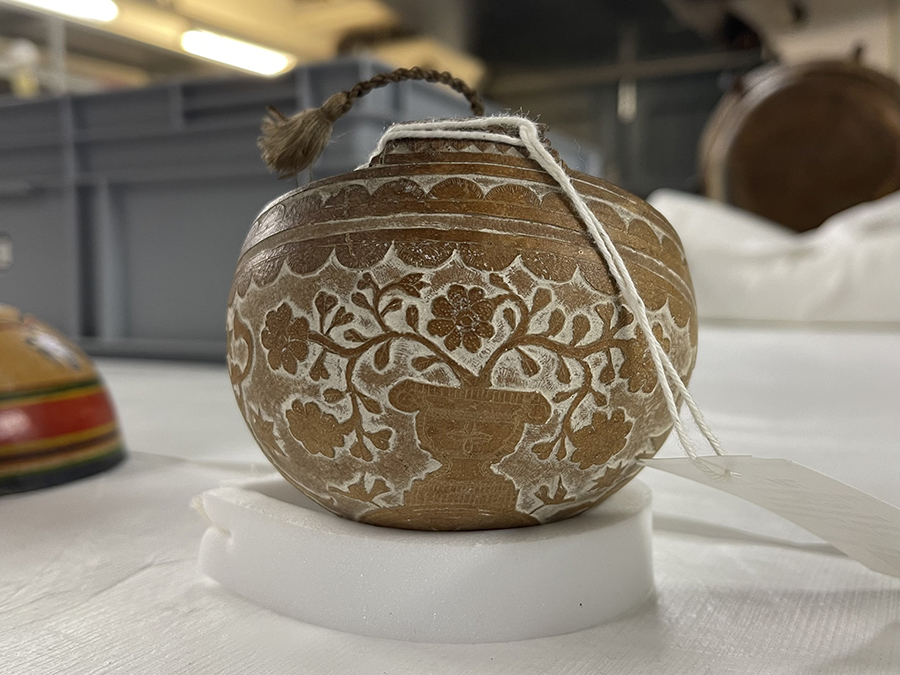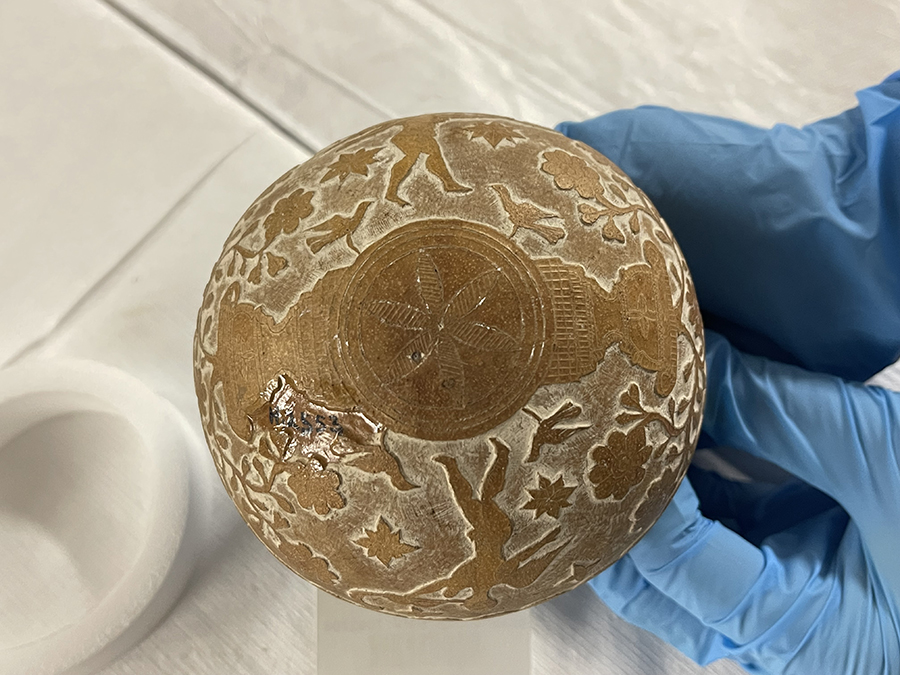Justin M. Brown
The Cosmic Calabash: Afro-Surinamese Art and Thought during the Period of Slavery
How can we know what enslaved people in the past thought about the world around them? Access to the inner lives of the enslaved poses a significant challenge for scholars due largely to a scarcity of documents that convey their stories in their own voices. In my research, I navigate these limitations by foregrounding sources that have been critically overlooked. I specifically investigate how enslaved people of African descent in the former Dutch colony of Suriname used a natural material from their environment—the calabash fruit—to preserve their thoughts and observations about the world. I show that when treated as legitimate sources of historical evidence, these objects provide invaluable insights into a complex system of thought.

Unrecorded artist (Afro-Surinamese), Calabash Vessel, c. 1823/1824, calabash and kaolin, 10 × 9.5 × 9.7 cm, Wereldmuseum, Rotterdam, Coll.nr. TM-H-2553
The calabash refers to the fruit of the tree Crescentia cujete L. Native to Central America, South America, and the Caribbean, this fruit is distinguished by its hard shell and spherical shape. It grows in abundance in Suriname, an important factor in determining its use as a staple of everyday life during slavery. While calabashes vary in size—usually from 5 to 25 centimeters—the objects I examine in my dissertation measure around 10 centimeters in diameter on average. These calabashes formed small bowls that a person might hold in one hand.
Enslaved Afro-Surinamese people decorated the outer surfaces of calabashes with carved designs, including figurative, geometric, and ornamental motifs. They represented themes that transcended the struggles of their everyday existence under slavery. In doing so, they crafted a narrative of their own—one that asserted their capacity to envision a world beyond their oppression. Through this artistic expression, they asserted their humanity and agency, engaging in a form of liberation that defied the dehumanizing confines of slavery. In essence, calabash art became a vehicle for asserting their thoughts, emotions, and imagination, offering a glimpse into a realm of possibility against the constraints of their reality.
My first year as the Samuel H. Kress Fellow allowed me to travel extensively in Suriname, the Netherlands, and Germany, where I conducted in-depth archival and object-based research. In Suriname, I visited important historical sites and worked with the archives of the Evangelische Broedergemeente (Moravian Church). In Europe, I consulted manuscripts written by colonial officials and missionaries in Suriname and examined calabashes in the collections of several museums. I used this foundational research to write the four chapters of my dissertation during the second year of my fellowship. Each chapter focuses on a different aspect of calabash art, beginning with an introduction that explains the stakes of the project, its theoretical underpinnings, and my interdisciplinary methodology, which draws on art history, textual analysis, and ethnographic studies.

Unrecorded artist (Afro-Surinamese), Calabash Vessel, c. 1823/1824, calabash and kaolin, 10 × 9.5 × 9.7 cm, Wereldmuseum, Rotterdam, Coll.nr. TM-H-2553
The first chapter examines the historical context of calabash art, exploring the dynamic ways in which cultural exchange shaped its development. Through a meticulous examination of historical records and surviving artifacts dating as early as the 18th century, this chapter unravels the intricate process by which enslaved people of African descent assimilated Indigenous calabash art into their cultural repertoire. The second chapter explores the ritual uses of carved calabashes. It specifically examines a collection of two carved calabashes found at a sacred site in the early 19th century. I argue that this context reveals that the calabashes were used as ritual containers to hold offerings for spirits. The third chapter analyzes the symbolic significance of the compositions and surface decorations of carved calabashes. Focusing on a specific group of calabashes, I investigate the aesthetic principle of formal balance as a representation of the interconnected relationship between opposing forces (spirit/human, male/female, life/death). The fourth chapter provides a detailed analysis of a carved calabash made sometime before 1831. I argue that its imagery documents Afro-Surinamese views on humans and spirits as agents within a collective moral universe.
During my year in residence, I have also been working on the forthcoming exhibition Spirit & Strength: Modern Art from Haiti with Kanitra Fletcher, associate curator of African American and Afro-Diasporic art at the National Gallery of Art. This exhibition will feature 21 artworks by modern and contemporary artists from Haiti, as well as a selection of artworks made by African American artists who traveled to Haiti during the 20th century. I have been involved in research, writing, and other curatorial tasks. The show will run from September 29, 2024, to March 9, 2025.
Yale University
Samuel H. Kress Fellow, 2022–2024
Beginning in the fall of 2024, Justin M. Brown will join the faculty of Boston College as assistant professor of art history and African and African Diaspora studies.
